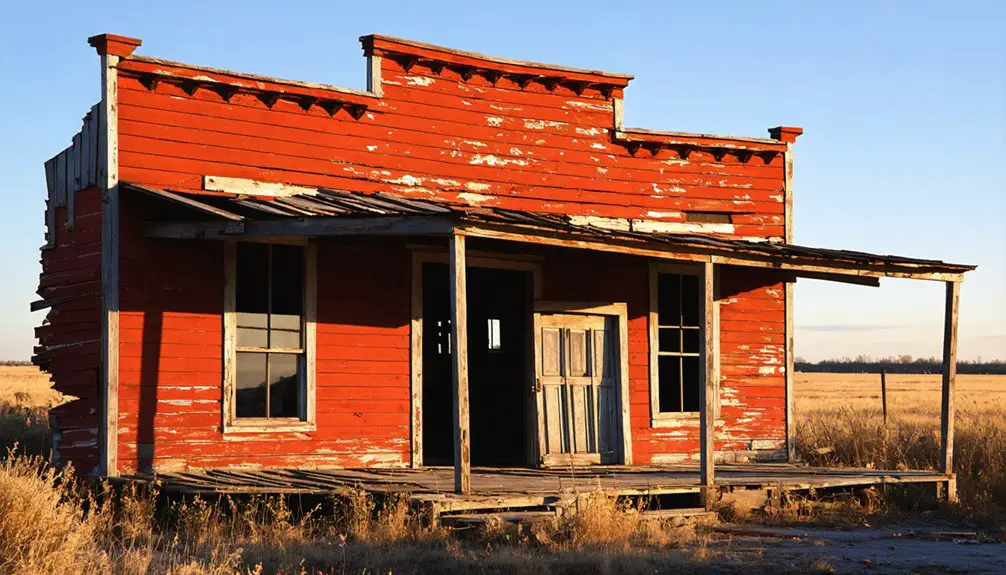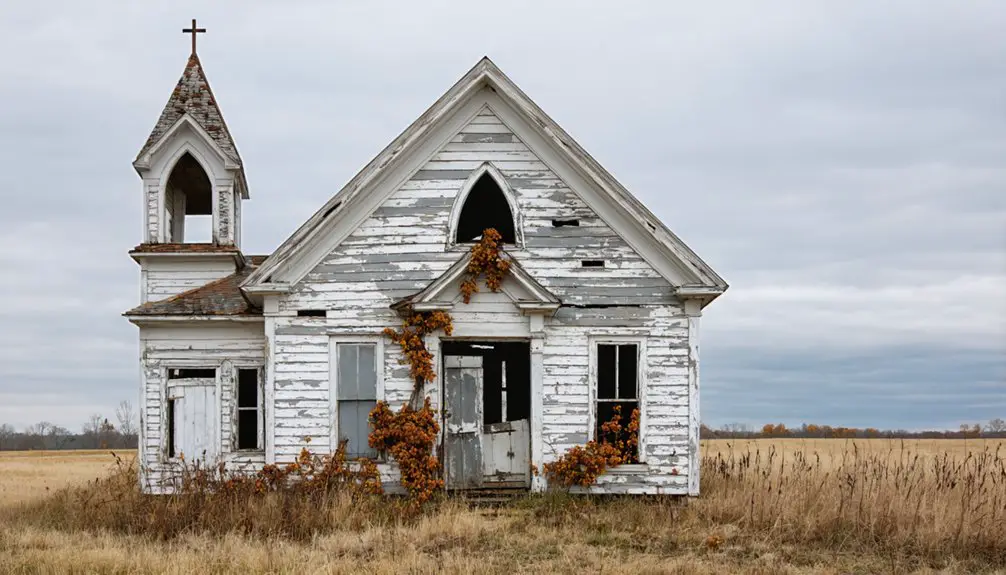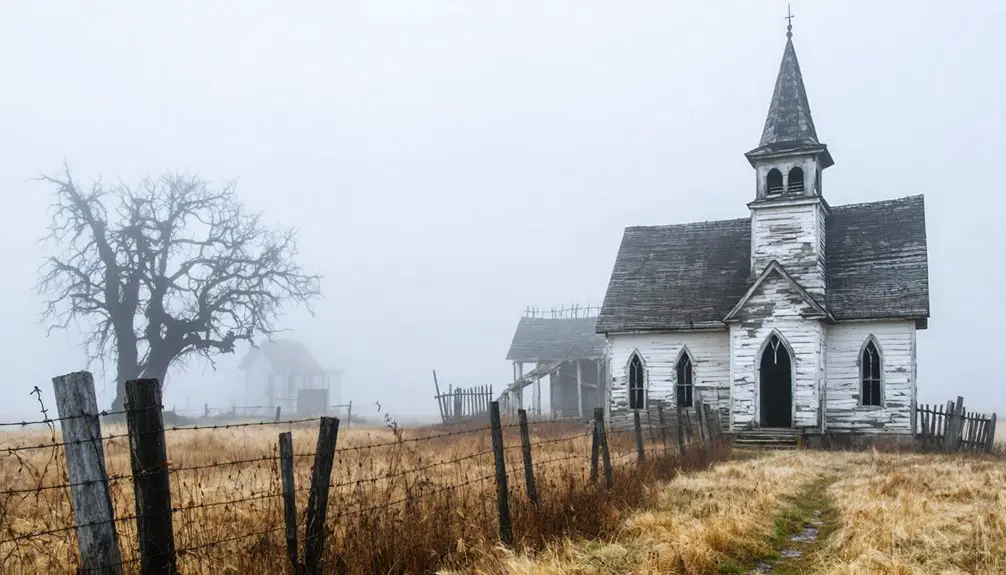You’ll find Georgia City’s ghost town remnants in Missouri, where this once-bustling 1830s settlement thrived during the railroad boom. Initially settled by Tennessee farmers near Jones Springs, the town expanded rapidly with railroad construction, attracting diverse workers and businesses. By the late 19th century, rerouted rail lines and economic shifts led to its decline. Today, you can explore foundational ruins, building fragments, and a historic cemetery that hint at the town’s fascinating past.
Key Takeaways
- Georgia City flourished as a strategic railroad settlement in 19th-century Missouri before becoming a ghost town due to economic decline.
- The town’s downfall began when railroad routes bypassed it, leading to factory closures and significant population loss.
- Physical remnants include building foundations, cemetery gravestones, and old railroad infrastructure marking former transportation routes.
- Local historical societies preserve the ghost town’s artifacts and maintain connections to Missouri’s railroad development history.
- The site demonstrates how changing transportation patterns and economic dependencies can lead to a community’s abandonment.
The Rise and Fall of a Railroad Settlement
When railroads expanded across Missouri in the 19th century, Georgia City emerged as a strategic settlement along the growing transportation network.
You’d find the town bustling with activity as railroad construction brought diverse laborers, economic opportunities, and essential infrastructure to the area. Similar to how Cousin John Thrasher provided housing for railroad workers, Georgia City developed accommodations to support its growing workforce. The construction relied heavily on enslaved laborers, following common practices of southern railroad development.
During its peak, you could witness multiple daily trains connecting Georgia City to regional markets and urban centers. The railroad expansion transformed this junction into a thriving hub, complete with depots, maintenance facilities, and housing for workers.
The community formation centered around these rail operations, with businesses and services springing up to support the growing population.
However, when railroad companies began realigning routes and shifting major hubs elsewhere, Georgia City’s decline was inevitable.
As trains stopped running, businesses closed, residents left, and the once-vibrant settlement became a ghost town.
Life in Early Georgia City
Before Georgia City became a railroad hub, its early settlement took shape amid the rolling landscapes of southwest Missouri in the 1830s. You’d have found the first settlers, mainly from Tennessee, establishing homesteads near essential water sources like Jones Springs. They’d carved out a living through frontier farming, cultivating wheat, corn, and tobacco while building homes from local timber.
Life centered around small family clusters where you’d gather with neighbors at the town square for social and civic activities. Similar to early Georgia settlers, the community enforced strict rules against drunken or vicious individuals. You’d trade with local Native American tribes until the Trail of Tears dramatically altered the region’s demographics.
The community grew slowly but steadily, with settlers focusing on subsistence farming and small-scale commerce. Like other Missouri settlements of the time, river transport routes were crucial for moving goods and supplies. You’d find basic infrastructure developing as the settlement evolved, supporting the needs of its roughly 500 residents.
Economic Shifts and Population Decline
Despite its early promise as a regional trading post, Georgia City’s economic fortunes began to crumble in the late 19th century.
The economic transformation hit the town hard as railroads bypassed its location and river trade declined. You’d have witnessed dramatic changes as factories closed, jobs disappeared, and younger residents sought opportunities elsewhere. Similar to the centrally planned economy of the Soviet era, the town’s rigid dependence on specific industries left it vulnerable to market shifts. The situation mirrored conditions seen during the 1930s when factory closures devastated communities across Georgia.
Key factors in Georgia City’s decline included:
- Rerouting of major rail lines that left the town isolated from crucial trade routes
- Closure of textile and agricultural processing facilities that once employed locals
- Competition from St. Louis that drew away investment and skilled workers
The resulting migration patterns showed a steady exodus, particularly among young workers.
As the population aged and services shut down, Georgia City’s transformation from bustling trade center to ghost town became inevitable.
Physical Remnants and Historical Landmarks
Today, Georgia City’s physical remnants offer only sparse glimpses into its former energy.
You’ll find mainly foundational ruins and scattered building fragments where churches, schools, and businesses once stood. The town’s cemetery serves as the most significant surviving landmark, featuring 19th and early 20th-century gravestones that tell stories of early settlers through their inscriptions.
Much like Hooker, Missouri, the cemetery remains one of the only testaments to the former residents who once called this Ozark settlement home.
Infrastructure remnants reveal traces of the town’s connectivity, with old roadbeds and possible railroad artifacts marking former transportation routes. Similar to failed zoning practices that affected other ghost towns, poor planning contributed to Georgia City’s eventual abandonment.
Natural features like rivers and hills that influenced the original settlement patterns remain visible, though they’ve contributed to the gradual deterioration of man-made structures.
While most physical structures have succumbed to time, cemetery preservation efforts by local historical societies help maintain this vital link to Georgia City’s past.
Historical markers near the site guide visitors through the ghost town’s layout.
Legacy and Impact on Missouri’s Development
Beyond its physical remnants, Georgia City left an enduring mark on Missouri’s development during the late 19th and early 20th centuries.
You’ll find its influence woven throughout the region’s cultural narratives, from pioneer life stories to the evolution of rural communities. Similar to Stony Dell Resort, Georgia City’s prominence diminished when major transportation routes were redirected. Like the former thriving Lumis Mill, the town’s economic centers eventually relocated to larger cities.
The town’s legacy shaped Missouri’s development in three key ways:
Missouri’s development was profoundly shaped by this town’s legacy, leaving lasting imprints on infrastructure, policy, and social patterns.
- Its rise and fall influenced the planning of transportation corridors, affecting how railroads and highways were routed throughout the state.
- Its economic patterns helped inform state policies on rural development and resource allocation.
- Its documented history now serves as a valuable case study for understanding demographic shifts and social resilience in Missouri.
The town’s story continues to impact historical preservation efforts and provides vital insights into how transportation technology changes dictated Missouri’s urban-rural organization.
Frequently Asked Questions
Are There Any Known Photographs of Georgia City During Its Peak Years?
A picture’s worth a thousand words, but you won’t find any historical photography from those peak years. Research shows there aren’t any widely known photographs available in major archives or publications.
What Happened to the Residents After They Left Georgia City?
You’ll find the residents’ fate followed typical Depression-era patterns: they scattered to nearby Missouri towns, seeking industrial jobs and farming work, while their community legacy lives on through descendants and local archives.
Were There Any Notable Crimes or Incidents in Georgia City’s History?
You won’t find documented crime incidents in the historical records – a pattern common for ghost towns where documentation was often lost or never created during their brief existence.
Did Any Famous People or Historical Figures Visit Georgia City?
Like footprints in shifting sand, you won’t find traces of famous visitors in the records. Historical significance faded without documented visits from any notable figures during the town’s brief existence.
Are There Guided Tours or Organized Visits to Georgia City Today?
You won’t find organized guided tours currently, but you’re free to explore the area independently. There’s no formal structure for historical insights or guided exploration of the remaining ghost town sites.
References
- https://www.youtube.com/watch?v=_b4p-SB3h1g
- https://www.ezhomesearch.com/blog/ghost-towns-in-georgia/
- https://www.onlyinyourstate.com/trip-ideas/missouri/road-trip-through-mo-ghost-towns
- https://www.geotab.com/ghost-towns/
- https://en.wikipedia.org/wiki/List_of_ghost_towns_in_Missouri
- https://www.georgiahistory.com/ghmi_marker_updated/thrasherville-where-atlanta-began/
- https://raycityhistory.wordpress.com/tag/atlantic-gulf-railroad/
- https://www.georgiaencyclopedia.org/articles/counties-cities-neighborhoods/atlanta/
- https://en.wikipedia.org/wiki/History_of_rail_transportation_in_the_United_States
- https://collections.shsmo.org/manuscripts/columbia/C2366/macon-county



